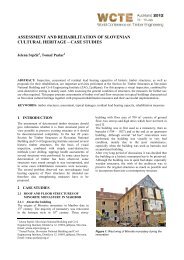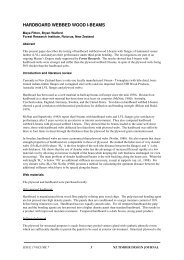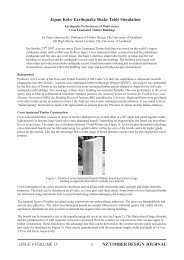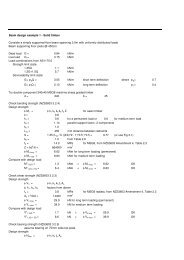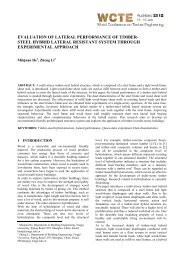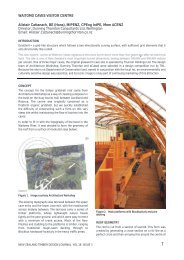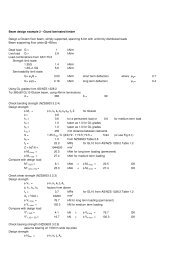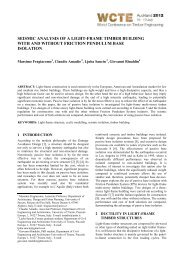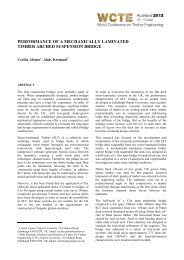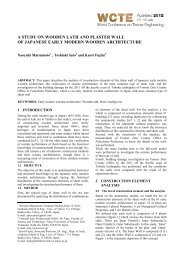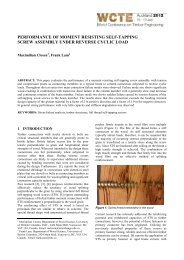Development of a design procedure for timber concrete composite ...
Development of a design procedure for timber concrete composite ...
Development of a design procedure for timber concrete composite ...
Create successful ePaper yourself
Turn your PDF publications into a flip-book with our unique Google optimized e-Paper software.
Notes on Figure 1:<br />
(a1) nails; (a2) glued rein<strong>for</strong>ced <strong>concrete</strong> steel bars; (a3, a4)<br />
screws; (b1, b2) connectors (split rings and toothed plates); (b3)<br />
steel tubes; (b4) steel punched metal plates; (c1) round<br />
indentations in <strong>timber</strong>, with fasteners preventing uplift; (c2)<br />
square indentations, with fasteners preventing uplift; (c3) cup<br />
indentation and pre-stressed steel bars; (c4) nailed <strong>timber</strong><br />
planks deck and steel shear plates slotted through the deeper<br />
<strong>timber</strong> planks; (d1) steel lattice glued to <strong>timber</strong>; (d2) steel plate<br />
glued to <strong>timber</strong>.<br />
Figure 1: Range <strong>of</strong> TCC connections [8].<br />
3.2 CONNECTION CHARACTERISATION<br />
The behaviour and effectiveness <strong>of</strong> the tested shear<br />
connections were assessed based on their strength<br />
(failure load or maximum load), stiffness and failure<br />
mode. The strength <strong>of</strong> the connection specimens was<br />
defined as the maximum load that can be applied in the<br />
push-out tests be<strong>for</strong>e failure. Depending upon the failure<br />
mode, the connection specimens may have some load<br />
carrying capacity following the maximum load resulting<br />
in a ductile behaviour. The failure modes were there<strong>for</strong>e<br />
carefully documented in all tests. The connection<br />
stiffness or slip modulus, which represents the<br />
resistance to the relative displacement between the<br />
<strong>timber</strong> joist and the <strong>concrete</strong> slab, is one <strong>of</strong> the key<br />
parameters that define the efficiency <strong>of</strong> a shear<br />
connection. Stiffness <strong>for</strong> the serviceability limit state<br />
(SLS) and ultimate limit state (ULS) are essential to<br />
characterise a shear connection. The stiffness <strong>for</strong> SLS<br />
(K ser ) corresponds to the inclination <strong>of</strong> the load-slip curve<br />
between the loading start point (generally taken as 10%<br />
<strong>of</strong> failure load to overcome “settling in”) and the 40% <strong>of</strong><br />
the failure load. The stiffness <strong>for</strong> ULS (K u ) corresponds<br />
to the inclination <strong>of</strong> the load-slip curve between the<br />
loading start point and the 60% <strong>of</strong> the failure load. As a<br />
general rule, it can be assumed that K u = (2/3) K ser .<br />
3.3 LABORATORY INVESTIGATION AT UTS –<br />
OBSERVATIONS AND STEPS TOWARDS SUITABLE<br />
CONNECTIONS<br />
A number <strong>of</strong> shear connections have been tested using<br />
push-out tests on full scale specimens and loaddeflection<br />
plots and stiffness <strong>for</strong> these connections have<br />
been determined. Parameters such as the type <strong>of</strong><br />
connector, shape <strong>of</strong> notches, use <strong>of</strong> mechanical anchors<br />
and <strong>concrete</strong> properties have been investigated and<br />
analysis <strong>of</strong> this data has led to number <strong>of</strong> conclusions.<br />
• Early research showed that the use <strong>of</strong> nail plates<br />
alone as shear connectors did not prove to be<br />
effective, whilst a combination <strong>of</strong> nail plates with<br />
either screws or <strong>concrete</strong> notches was more effective<br />
- especially incorporation <strong>of</strong> <strong>concrete</strong> notches.<br />
Figure 2: Schematic <strong>of</strong> load-slip behaviour <strong>of</strong> types <strong>of</strong><br />
connection [8].<br />
Connections in groups (a), (b) and (c) allow relative slip<br />
between the <strong>timber</strong> element and the <strong>concrete</strong> member,<br />
that is, the cross-sections do not remain planar under<br />
load – and the strain distribution is not continuously<br />
linear in the <strong>composite</strong> cross-section. Only connections<br />
in group (d) exhibit a planar behaviour, corresponding<br />
thus to fully <strong>composite</strong> action between <strong>timber</strong> member<br />
and the <strong>concrete</strong> slab. It can be assumed that TCC<br />
structures assembled with connectors from group (a)<br />
achieve 50% <strong>of</strong> the effective bending stiffness <strong>of</strong> TTC<br />
systems constructed with connectors from group (d) [7].<br />
• A number <strong>of</strong> <strong>concrete</strong> notch type shear connections<br />
were then tested such as trapezoidal, triangular type<br />
and polygonal notch and parameters such as slant<br />
angle, use <strong>of</strong> either coach screw or normal wood<br />
screw as mechanical fastener, inclination <strong>of</strong> the<br />
mechanical fastener, inclination <strong>of</strong> the slanting face<br />
and use <strong>of</strong> low shrinkage <strong>concrete</strong> were studied.<br />
• Use <strong>of</strong> coach screws has the advantage <strong>of</strong> deeper<br />
penetration depth inside the <strong>concrete</strong> slab in<br />
comparison to normal wood screws due to their<br />
longer length. This resulted in a single coach screw<br />
providing higher shear capacity than a combination <strong>of</strong><br />
four wood screws.<br />
• Interesting results were obtained from the triangular<br />
type connections as these connections generally<br />
exhibited higher strength and stiffness than the<br />
trapezoidal notch connections and especially so <strong>for</strong><br />
8 NEW ZEALAND TIMBER DESIGN JOURNAL VOL 19· ISSUE 2



